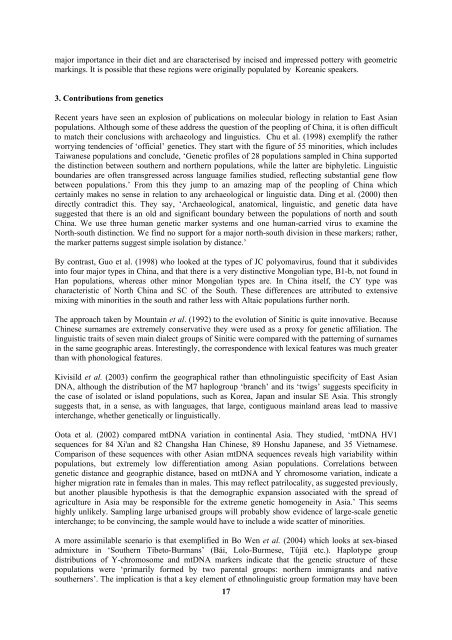Geneva paper 2004 submit.pdf - Roger Blench
Geneva paper 2004 submit.pdf - Roger Blench
Geneva paper 2004 submit.pdf - Roger Blench
Create successful ePaper yourself
Turn your PDF publications into a flip-book with our unique Google optimized e-Paper software.
major importance in their diet and are characterised by incised and impressed pottery with geometric<br />
markings. It is possible that these regions were originally populated by Koreanic speakers.<br />
3. Contributions from genetics<br />
Recent years have seen an explosion of publications on molecular biology in relation to East Asian<br />
populations. Although some of these address the question of the peopling of China, it is often difficult<br />
to match their conclusions with archaeology and linguistics. Chu et al. (1998) exemplify the rather<br />
worrying tendencies of ‘official’ genetics. They start with the figure of 55 minorities, which includes<br />
Taiwanese populations and conclude, ‘Genetic profiles of 28 populations sampled in China supported<br />
the distinction between southern and northern populations, while the latter are biphyletic. Linguistic<br />
boundaries are often transgressed across language families studied, reflecting substantial gene flow<br />
between populations.’ From this they jump to an amazing map of the peopling of China which<br />
certainly makes no sense in relation to any archaeological or linguistic data. Ding et al. (2000) then<br />
directly contradict this. They say, ‘Archaeological, anatomical, linguistic, and genetic data have<br />
suggested that there is an old and significant boundary between the populations of north and south<br />
China. We use three human genetic marker systems and one human-carried virus to examine the<br />
North-south distinction. We find no support for a major north-south division in these markers; rather,<br />
the marker patterns suggest simple isolation by distance.’<br />
By contrast, Guo et al. (1998) who looked at the types of JC polyomavirus, found that it subdivides<br />
into four major types in China, and that there is a very distinctive Mongolian type, B1-b, not found in<br />
Han populations, whereas other minor Mongolian types are. In China itself, the CY type was<br />
characteristic of North China and SC of the South. These differences are attributed to extensive<br />
mixing with minorities in the south and rather less with Altaic populations further north.<br />
The approach taken by Mountain et al. (1992) to the evolution of Sinitic is quite innovative. Because<br />
Chinese surnames are extremely conservative they were used as a proxy for genetic affiliation. The<br />
linguistic traits of seven main dialect groups of Sinitic were compared with the patterning of surnames<br />
in the same geographic areas. Interestingly, the correspondence with lexical features was much greater<br />
than with phonological features.<br />
Kivisild et al. (2003) confirm the geographical rather than ethnolinguistic specificity of East Asian<br />
DNA, although the distribution of the M7 haplogroup ‘branch’ and its ‘twigs’ suggests specificity in<br />
the case of isolated or island populations, such as Korea, Japan and insular SE Asia. This strongly<br />
suggests that, in a sense, as with languages, that large, contiguous mainland areas lead to massive<br />
interchange, whether genetically or linguistically.<br />
Oota et al. (2002) compared mtDNA variation in continental Asia. They studied, ‘mtDNA HV1<br />
sequences for 84 Xi'an and 82 Changsha Han Chinese, 89 Honshu Japanese, and 35 Vietnamese.<br />
Comparison of these sequences with other Asian mtDNA sequences reveals high variability within<br />
populations, but extremely low differentiation among Asian populations. Correlations between<br />
genetic distance and geographic distance, based on mtDNA and Y chromosome variation, indicate a<br />
higher migration rate in females than in males. This may reflect patrilocality, as suggested previously,<br />
but another plausible hypothesis is that the demographic expansion associated with the spread of<br />
agriculture in Asia may be responsible for the extreme genetic homogeneity in Asia.’ This seems<br />
highly unlikely. Sampling large urbanised groups will probably show evidence of large-scale genetic<br />
interchange; to be convincing, the sample would have to include a wide scatter of minorities.<br />
A more assimilable scenario is that exemplified in Bo Wen et al. (<strong>2004</strong>) which looks at sex-biased<br />
admixture in ‘Southern Tibeto-Burmans’ (Bái, Lolo-Burmese, Tûjiä etc.). Haplotype group<br />
distributions of Y-chromosome and mtDNA markers indicate that the genetic structure of these<br />
populations were ‘primarily formed by two parental groups: northern immigrants and native<br />
southerners’. The implication is that a key element of ethnolinguistic group formation may have been<br />
17
















